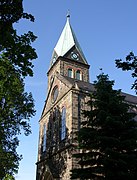Joseph Campani
Joseph Campani (born April 2, 1856 in Hötting ; † July 12, 1931 in Beuron ) was a Benedictine and architect .
Live and act
Joseph Maria Franz de Paula Campani came from a family of craftsmen who had been running a locksmith's shop in Hötting No. 410 (today: Höttingergasse 17 in Innsbruck ) for generations. After the early death of sister Franziska in 1861 and mother Dorothea in 1862, the parents' house was auctioned off and father Johann left the place with his son.
In 1877 Joseph Campani joined the order of the Benedictines , made his profession in 1880 and was given the name Frater Pirmin. He was ordained a priest in 1884 and was now called Father Pirmin Campani OSB. He belonged to the founding colony of the Seckau monastery in Styria and dedicated himself to construction there. In 1896 the basilica " Maria Rosenkranzkönigin " was inaugurated in Radibor ( Saxony ) , which was built according to Campani's plans. After a falling out with the order, Father Pirmin converted to the Protestant faith , found a job in the Bethel building department under Karl Siebold in 1900 and headed the "Institute for Church Art" there. In 1902 Joseph Campani married the widow Auguste Strohmann, who brought their daughter Emilia into the marriage. After resigning from the building department, he went into business for himself as an architect in 1904 and built churches in Brake near Bielefeld (1909), Hamborn- Schmidthorst (1911), Hagedorn (1911), Christ Church Obernbeck (1914), Oberlübbe (1913) and Obernbeck (1914) , whereby he attached great importance to the furnishing and painting of the places of worship.
Impoverished by the lack of orders during the First World War and lonely after the death of his wife in 1920, Joseph Campani converted to the Catholic faith shortly before his death and was accepted into the Archabbey of Beuron in 1931 . There he died two months later after a stroke at the age of 75 and was buried in the monastery cemetery as a monk, Father Pirmin Campani OSB.
Church buildings
Maria Rosary Queen (1896) in Radibor
Brake Evangelical Church (1909) in Brake
Evangelical Gnadenkirche (1911) in Hamborn-Schmidthorst (today Duisburg-Neumühl )
Evangelical Church Hagedorn (1911) in Hagedorn , Kirchlengern parish
Christ Church Obernbeck (1914) in Löhne
literature
- Ulrich Althöfer: The architect Karl Siebold (1854–1937). On the history of Protestant church building in Westphalia. Luther-Verlag, Bielefeld 1998, ISBN 3-7858-0394-X , pp. 68-71.
- Bavarian Benedictine Academy (ed.): Studies and communications on the history of the Benedictine order and its branches . 1st issue, Munich 1932.
- Christian art paper for church, school and home. No. 3. Stuttgart 1907. (See also: Deutsche Goldschmiedezeitung from 1907)
- Benno Roth: The restoration of the Seckau basilica under Abbot Ildephons Schober 1887–1908. (= Seckauer Geschichtliche Studien , No. 12.) Seckau 1956.
- Benno Roth: Seckau. The cathedral in the mountains. Graz / Vienna / Cologne 1983.
Individual evidence
- ↑ Agnes Winar-Orses: Radibor - a historically significant parish , supplement to: Winarjec-Orsesowa, Hanza, Radwor, Starodawna cyrkwinska wjes, Radwor 2000
- ↑ Rudolf Patt: Brief overview of the history of the origin of the evangel. Church in Brake i. Westf. Bielefeld 1909.
- ↑ Braker Church , bielefeld.de, accessed on March 25, 2014.
- ↑ Erich Binder: The Evangelical Church Community Hamborn. A contribution to the history of the church in Duisburg-Hamborn. Duisburg 1972.
- ↑ Erich Scheiding: Hagedorn Church and its history. 1999 wages.
- ↑ The Hagedorn Church at www.kirche-hagedorn.de , accessed on March 25, 2014
- ↑ Christ Church Obernbeck on http://www.kirchengemeinde-obernbeck.de/unsere-gemeinde/christuskirche/
- ↑ Detlef Scheiding: "You will be amazed ..." The monk Campani and the church in Obernbeck. Obernbeck 2004, ISBN 3-00-013778-5 .
| personal data | |
|---|---|
| SURNAME | Campani, Joseph |
| ALTERNATIVE NAMES | Campani, Joseph Maria Franz de Paula (full name) |
| BRIEF DESCRIPTION | Benedictine monk and architect |
| DATE OF BIRTH | April 2, 1856 |
| PLACE OF BIRTH | Hötting |
| DATE OF DEATH | July 12, 1931 |
| Place of death | Beuron |




